Shipping Container Bathrooms: Clean, Convenient, and Hygienic
JANUARY 22, 2022 BY
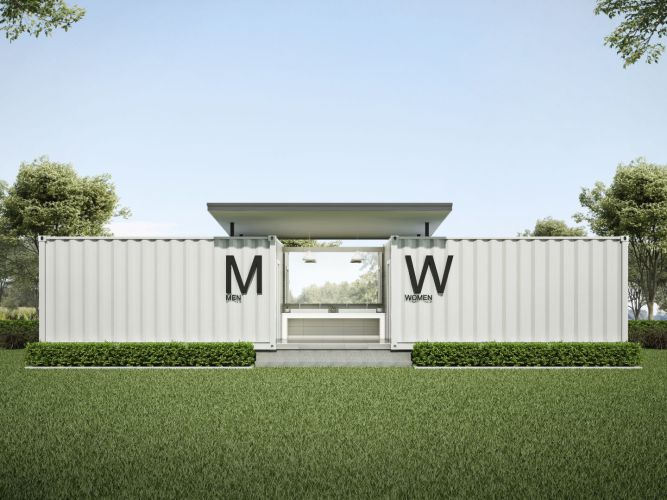
While shipping container offices, warehouses, restaurants, and pop-up shops have already become hugely popular, some of the lesser-known container structures include bathrooms and restrooms.
There are a few reasons why shipping container bathrooms serve as smart alternatives to traditional buildings. For one, their high-strength, Corten steel construction is incredibly weather-resistant, making it perfect for placing in any outdoor setting. As opposed to other portable bathrooms, shipping containers are highly flexible and give you the freedom to customize the space according to your needs.
Prefabricated shipping container bathrooms also allow faster completion of construction projects.
Pre-built bathroom structures can also be attached to your main building. Remember, a modular, shipping container bathroom is an off-site construction element, which means the bathroom manufacturer pieces together the fixtures and components per your chosen design. Containers are delivered ready for use at your site.
Read on below to learn more about shipping container bathrooms.
What is a Shipping Container Bathroom?
Container bathrooms are commercial, user-friendly structures that use repurposed shipping containers in their construction.
You can modify the container's interiors completely to fit essential utilities like toilet blocks, plumbing, running water, climate control, ventilation system, and other amenities as per your comfort.
The result is a highly accessible structure that functions the same as any indoor bathroom while offering maximum comfort.
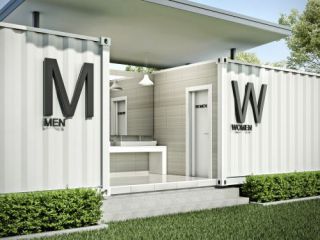
Why Do You Need Shipping Container Restrooms?
If port-a-potties already exist, why are folks increasingly leaning towards shipping container bathrooms instead?
Although both structures are highly portable, there are several key advantages that containers offer over port-a-potties. Let's look at why shipping container bathrooms are a better option for outdoor public convenience buildings.
In-Built Plumbing
Port-a-potties lack a built-in plumbing system and sink. As a result, most of the waste generated in such toilets gets accumulated in a vat. On the contrary, shipping container bathrooms come equipped with a plumbing solution fitted with flushable toilets, sinks, and running water.
More Control Over Foul Odor
You can install ventilation systems in a container restroom, along with motion-activated vent fans, air conditioning, vertical sliding windows, etc. Meanwhile, port-a-potties use a blue antibacterial liquid for odor control, which may not be as effective as a fully ventilated system.
Better Sanitation and Cleaning
Cleaning a port-a-potty can be challenging since you need to pump the entire unit to dispose of the generated waste. A running water restroom made from shipping containers features drains and sewer lines that automatically dispose of waste. You can also install false-wood vinyl or vinyl-covered gypsum flooring that are slip-resistant and easy to clean.
Cost-Efficient
The rental price of port-a-potties can range anywhere between $175 to $500 per month or up to $6,000 for a year.
*Data from: https://www.portapotty.net/rental/
For that same amount of money, you can buy a 20-foot shipping container and make basic customizations as per your needs.
If you want more hygiene, comfort, and user-friendly facilities, then shipping containers remain the preferred choice.
How Can Shipping Container Restrooms Boost Employee Satisfaction and Morale?
It is a common notion that restrooms at industrial job sites are probably unsanitary. Traditional portable bathrooms lack the desired cleanliness, comfort, and hygiene. Modified container units offer an efficient, durable solution that can work wonders for boosting your employees' morale and operating efficiency. When workers are comfortable and healthy using a hygienic washroom, job satisfaction, and productivity also increase.
Shipping container restrooms are:
- Weather-resistant
- Robust
- Pre-fabricated
- Highly portable
- Easy to install on-site
- Clean and Hygienic
Some of the container modifications you can make and the systems you can install are:
- Heating, Air-Conditioning, and Climate-control units
- Motion-activated vent fans
- Indoor LED lights
- Waterproof, slip-resistant flooring
- Stainless steel urinals and sinks
- Hand dryers
- Lockable container doors
- Private stalls
How Do These Container Bathroom Features Help?
A fully operational, climate-controlled comfort station provides employees with the much-needed break from excess heat and cold at the job site.
The easy-to-clean features in a shipping container restroom also reduce the labor, cleaning time, and expenses incurred in scrubbing toilets. With indoor LED and photocell lights, you can also significantly reduce energy costs.
Employees tend to work with higher concentration and efficiency when they feel comfortable, refreshed, and content at their workplace. Shipping container bathrooms are one of the ways to provide a desirable workplace to your workers.
Offering a comfortable place to work can even give you an edge during new staff recruitments. You are also more likely to retain your best personnel, as people tend to remain at the jobs where they feel comfortable and respected for their basic sanitation rights.
If your goal is improving productivity at the workplace while keeping a check on operational costs, shipping container restrooms can help.
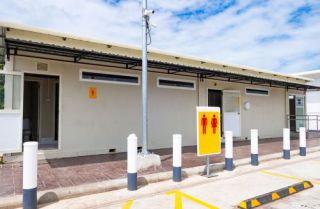
What are the Features You Can Include in Shipping Container Restrooms?
The first step in designing a shipping container bathroom is determining the size and floor plan.
Shipping containers come in the following ISO sizes: 10 ft., 20 ft., and 40 ft.
If you need a small bathroom or restroom with one or two stalls, 10-foot or 20-foot containers are perfect, while 40-foot containers are well-suited for large public restrooms with 5 to 8 stalls.
After selecting an appropriate container, you must look for a suitable floor plan that best delivers the purpose, function, and aesthetics. For example, a single, solid-steel man door is convenient for small offices.
However, when planning for a public event or a large workplace, it is best to have individual stalls with private entries for each booth.
Some standard features that you can add to your container restroom are:
- Waterproof flooring
- Hand dryer
- Sink
- Showers
- Sliding windows
- Electricity
- Water Heaters
- Odor management systems
- Lounge Area
- Shelves and closets
- Safety exit
It is best to go for an ADA-compliant layout whenever you design the floor plan and the features. Depending upon the design, you may also want to add different elements for male, female, and gender-neutral restrooms.
Where Can You Use Shipping Container Bathrooms and Restrooms?
Shipping containers are industrial-grade units that can resist weathering in all kinds of outdoor environments, making them perfect for outdoor projects. A running water restroom is a great alternative for community events, festivals, and non-profit outdoor activities. Some of the places where you can use shipping container restrooms include:
- Construction and manufacturing sites
- Festivals, concerts, and outdoor events
- Parks, campsites, and grounds
- Public conferences and gatherings
- Disaster relief and rehabilitation
- Developments at remote locations
- City centers
- Industrial facilities
- Off-shore rigs, power plants, and refineries
- Mining areas
- Schools and training centers
- Athletic and sports arenas
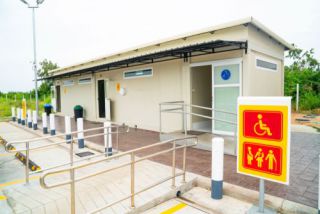
What is the Cost of Installing a Container Bathroom?
Setting up a shipping container restroom can cost you anywhere between $1,000 to $10,000.
The price of running water restrooms depends upon the size, level of modifications, additional utilities, type and condition of the container, and delivery location. If you choose to add more features like a shower or vent fans to remove the moisture buildup, you may incur additional expenses.
The Installation Process
When designing a container bathroom or restroom, you have to locate the position of the sink, toilet, and shower to minimize the plumbing cost. In addition, placing your bathroom at the end of the container helps reduce the number of interior walls and reduces your expenses.
You can then introduce tiling to your container bathroom. There are two ways to approach this process: half-tiles (6-8 inches from the floor to the wall) or full-tiles (covering the entire space except the ceiling). You can choose any of these options as per your budget. Tiling also helps determine whether your piping will be concealed or exposed.
If you plan to move the container unit frequently, you must place the toilet on an elevated platform. This allows the waste to exit to a septic tank or ground holes via an external plumbing source and reduce your cleaning expenditure.
You must also leave at least 3 ft. of space off the ground to create a crawl space for regular maintenance to avoid any significant repair cost in the future.
Bathroom Designs and Examples
When creating the floor plans, you must keep in mind the purpose of your unit. Some questions to consider are:
- Is it a one-stall bathroom or multi-facility area?
- Do you want urinals?
- What kind of floors would you prefer?
- Will your space have a shower area?
- Do you want climate-controlled spaces with an interior door?
These factors can help you design efficiently and save on building costs. Listed below are some standard container designs:
- One stall with separate entries
- Multiple individuals stalls with a single entry door
- One main room with several urinals combined with private entry toilets
- Portable Public Bath
- Running Water Restrooms
- Bathroom Block Designs
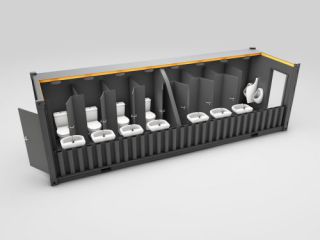
Look at how this couple turned a shipping container into a highly functional bathroom for their home.
Conclusion
Shipping container bathrooms are a hygienic, comfortable, and convenient alternative to traditional portable toilets and restrooms. The flexible structure of a container is easy to modify, clean, and incorporate into the design of your existing structure. Still, it is crucial to select an appropriate container to create the most efficient floor plans.
At Mobile Modular Portable Storage, we understand your container needs. Our team of container specialists can help you find the most appropriate containers for your bathrooms, restrooms, and other industry-specific applications. We also have our own fleet of trailers and A+ drivers who deliver containers to all the major locations in the United States.
Call us today at 866-459-7600 to get in touch with us to learn more about our container solutions.
FAQs
Can You Put a Bathroom In a Shipping Container?
Yes. The modular structure of shipping containers allows you to completely modify the interiors and add bathroom stalls, plumbing, showers, sinks, and electrical utilities to create efficient public restrooms.
How Do You Add Plumbing to a Shipping Container?
You can attach plumbing and sewer lines that open externally to an outdoor source. You must first select a suitable location for your plumbing fixtures and determine the piping connection. Next, you must connect the fixtures with a source and sink for a hassle-free flow. Placing the container on a platform or creating elevated flooring can help create space for the plumbing utilities.
What Kind of Floor Does a Shipping Container Have?
A shipping container can have durable vinyl-composite flooring, hardwood and timber flooring, and vinyl-covered gypsum flooring. You can also add waterproof and slip-resistant tiling over the floor for easy cleaning.
How Much Does a Shipping Container Cost?
Shipping containers can cost anywhere between $2,000 to $8,000 depending on their size, condition, amount of modifications, utilities, and delivery charges.